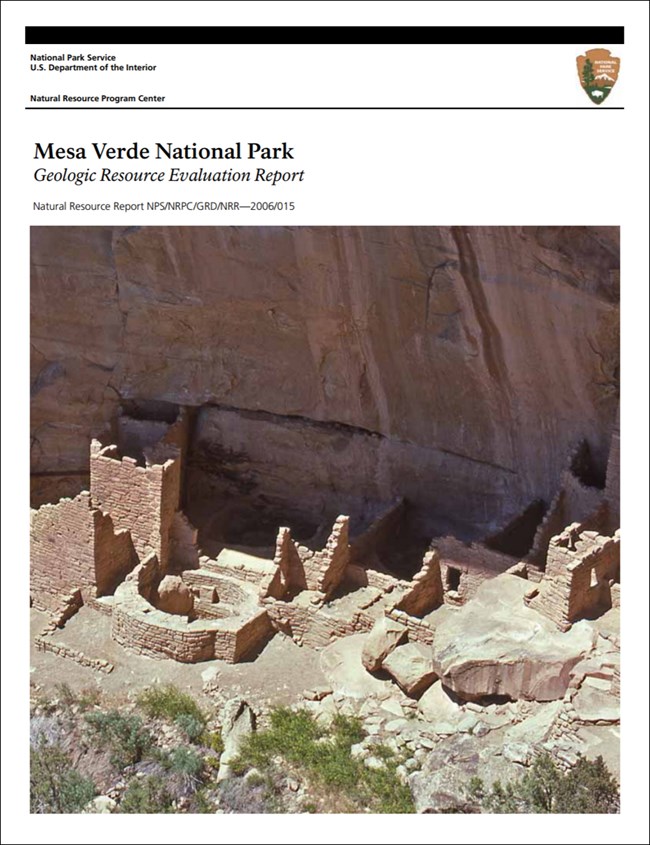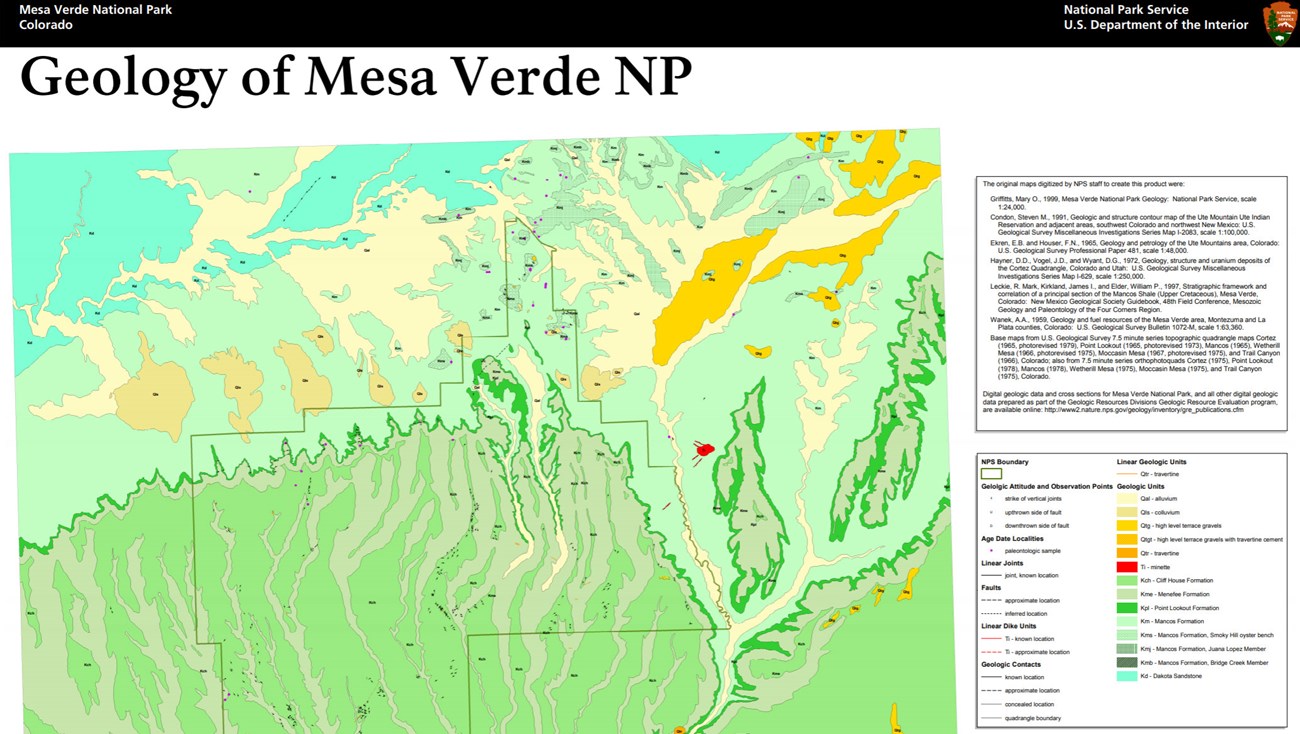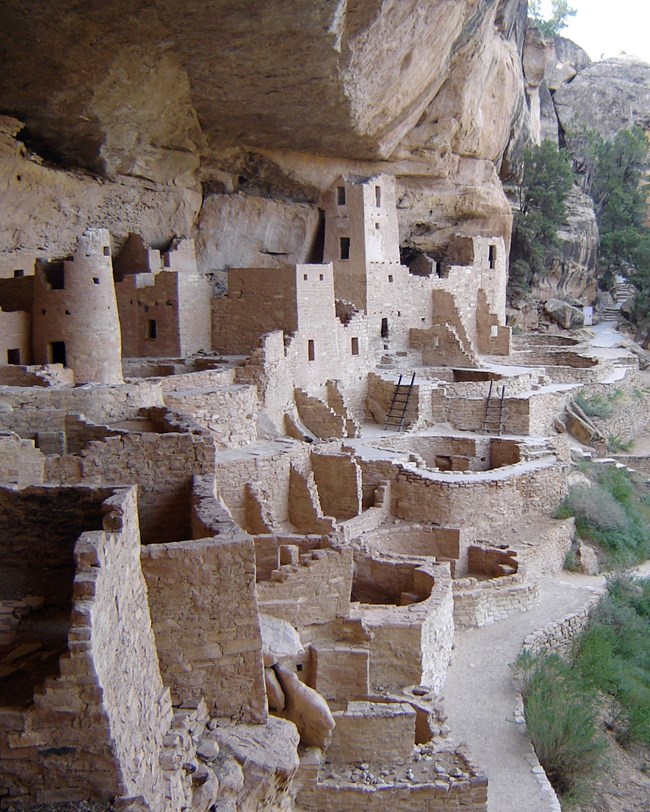Last updated: July 10, 2024
Article
NPS Geodiversity Atlas—Mesa Verde National Park, Colorado
Geodiversity refers to the full variety of natural geologic (rocks, minerals, sediments, fossils, landforms, and physical processes) and soil resources and processes that occur in the park. A product of the Geologic Resources Inventory, the NPS Geodiversity Atlas delivers information in support of education, Geoconservation, and integrated management of living (biotic) and non-living (abiotic) components of the ecosystem.

Introduction
Mesa Verde National Park (MEVE) is located in Montezuma County, southwestern Colorado near the Four Corners region where Arizona, Colorado, New Mexico, and Utah meet. Established on June 29, 1906, MEVE contains approximately 21,240 hectares (52,485 acres) of an archeological landscape that includes more than 600 well-preserved prehistoric cliff dwellings and more than 5,000 archeological sites (National Park Service 2016a). Ancestral Puebloans inhabited the park region from about 550 to 1300 CE, and numerous sites throughout MEVE provide insights into Ancestral Puebloan culture including Far View Sites, the Mesa Top Loop, Step House, the Badger House Community at Wetherill Mesa, Cliff Palace, Balcony House, Long House, and Spruce Tree House. The boundaries of MEVE include about 1,347 km2 (520 mi2 ) of deeply dissected tableland on the Colorado Plateau, including about 32 km (20 mi) of hiking trail scattered throughout the park (Graham 2006). In recognition of its valuable cultural resources, MEVE was among the first sites designated a United Nations Educational Scientific and Cultural Organization (UNESCO) World Heritage Cultural Site on September 6, 1978.
Geologic Setting
Mesa Verde National Park encompasses roughly 210 km2 (81 mi2 ) of Mesa Verde, a broad and deeply dissected, flat-topped mesa with numerous north–south-trending, steep-sided canyons. Mapped geologic units within the park include rocks of the Cretaceous Mesaverde Group (Point Lookout Sandstone, Menefee Formation, and Cliff House Sandstone) and Mancos Shale, and younger Quaternary surficial deposits. The notable massive cliffs and alcoves of MEVE consist of porous, erosion-resistant sandstones of the Cliff House Sandstone. The slopes beneath the cliffs are less resistant and composed of siltstone, mudstone, or shale of the Menefee Formation. Because the underlying strata of the Menefee Formation is less permeable than the overlying Cliff House Sandstone, groundwater flows along the contact of the two formations and emerges as springs or seeps along the canyon walls (Graham 2006). The alcoves and cliff dwellings of the Ancestral Puebloans are the result of these springs and seeps as they were an important source of water.
Paleontological Resources
Mesa Verde is geographically situated in a highly fossiliferous region of North America once submerged by the Western Interior Seaway until the end of the Cretaceous (Tweet et al. 2009). Paleontological resources are documented from three units at the park: Mancos Shale (Cretaceous), Mesa Verde Group; Point Lookout Sandstone (Upper Cretaceous); and Mesa Verde Group, Menefee Formation (Upper Cretaceous). Fossil specimens found within the park include plant remains, ammonites, pyritized clams, gastropods, bivalves, foraminifera, shark teeth, fish bones and teeth, and trace fossils.
All NPS fossil resources are protected under the Paleontological Resources Preservation Act of 2009 (Public Law 111-11, Title VI, Subtitle D; 16 U.S.C. §§ 470aaa - 470aaa-11).
Cave and Karst
Mesa Verde contains significant cliff dwellings of the ancestral Puebloan people. These cliff dwellings were built in what could have originated as a cave or alcove, and at times were later modified for the occupancy of the Puebloans. Limestone is present at the park and is formed in the Upper Cretaceous (100 million years ago) Juana Lopez Member and Bridge Creek Member of the Mancos Shale.
All NPS cave resources are protected under the the Federal Cave Resources Protection Act of 1988 (FCRPA)(16 U.S.C. § 4301 et seq.).
Geologic Hazards
The sandstone cliffs at Mesa Verde are susceptible to ongoing frost weathering and erosion, which can lead to unstable cliffs. The siltstone, mudstone, and shale slopes beneath the cliffs are not resistant to erosional forces. These natural geologic conditions can cause rockfall which is a major hazard to the park, visitor safety, and cultural artifacts
Regional Geology
Mesa Verde is a part of the Colorado Plateaus Physiographic Province and shares its geologic history and some characteristic geologic formations with a region that extends well beyond park boundaries.
- Scoping summaries are records of scoping meetings where NPS staff and local geologists determined the park’s geologic mapping plan and what content should be included in the report.
- Digital geologic maps include files for viewing in GIS software, a guide to using the data, and a document with ancillary map information. Newer products also include data viewable in Google Earth and online map services.
- Reports use the maps to discuss the park’s setting and significance, notable geologic features and processes, geologic resource management issues, and geologic history.
- Posters are a static view of the GIS data in PDF format. Newer posters include aerial imagery or shaded relief and other park information. They are also included with the reports.
- Projects list basic information about the program and all products available for a park.
Source: NPS DataStore Saved Search 3013. To search for additional information, visit the NPS DataStore.
A NPS Soil Resources Inventory project has been completed for Mesa Verde National Park and can be found on the NPS Data Store.
Source: NPS DataStore Saved Search 3060. To search for additional information, visit the NPS DataStore.
Related Articles
Mesa Verde National ParkNational Park Service Geodiversity Atlas
The servicewide Geodiversity Atlas provides information on geoheritage and geodiversity resources and values within the National Park System. This information supports science-based geoconservation and interpretation in the NPS, as well as STEM education in schools, museums, and field camps. The NPS Geologic Resources Division and many parks work with National and International geoconservation communities to ensure that NPS abiotic resources are managed using the highest standards and best practices available.


